I’ve never had an out of body experience but watching Dopesick might come somewhere close.
As the drama series depicting the carnage caused by OxyContin in the US played out in front of my eyes, I was having flashbacks to being prescribed the drug myself here in the UK.
Although compelling and superbly acted, it’s not a pretty show to watch.
But I can tell you first hand, it’s even worse to to be in need – then in want – of this dangerous opioid medicine.
It started for me while I was working long shifts on the news desk of daily paper.
I was somewhere down a path of what would lead to 14 operations and five miscarriages.
The cause was an undiagnosed gynae condition called endometriosis.
It would be years – and a life-saving operation later – before it would be definitively diagnosed.
But in the mean time I was in constant pain.
‘Have you thought about OxyContin?’
It got so bad that I had two months attached to a morphine driver on my couch at home, seeing palliative care nurses each day.
I was all but absent from my life.
Watching my husband take care of our kids and our home while holding down his job, while I just lay there, was soul crushing.
So I remember very clearly the day a very concerned district nurse told me about a “non-addictive” painkiller called OxyContin.
The inverted commas are deliberate, by the way.
We know now that’s utterly false.
The promise was that this miraculous medicine would not only mean taking less medicine like morphine, it wasn’t going to leave me dependent on painkillers.
Promise seemed too good to be true
I jumped at the chance of being pain free, never mind the prospect of getting some semblance of my life back.
It’s a scenario dramatised in the show Dopesick.
Except there Michael Keaton is the doctor and genuine in-pain patients don’t know what they’re about to let themselves in for.
Were sales reps like Billy deceived as well? Or were they also consumed by greed? #DopesickHulu pic.twitter.com/Fpq7QRI1tA
— Dopesick On Hulu (@DopesickOnHulu) December 3, 2021
To start with it was as miraculous as it sounded.
I was off the morphine and had no more need for nurses to see me every day at home.
Unlike what used to happen in America, OxyContin was never freely given to me.
As a controlled drug it always required a signature and a wait behind people getting methadone to collect my month’s supply.
‘Saying no to OxyContin would be harder than saying yes’
Truthfully I didn’t know there was any issue with it until I decided I no longer needed it.
I had whittled down my anti-sickness medicine.
A hysterectomy meant I no longer needed some other tablets.
Upping exercise and making changes to my diet eradicated the need for pills for my bowel.
So it was a natural progression to stop taking the pain meds too.
I should say at this point I was on the smallest possible dose.
Several scenes in the programme – which is based on Beth Macy’s book, Dopesick: Dealers, Doctors and the Drug Company that Addicted America – reveal the sickening extent Purdue Pharma went to in order to hike up the doses of the slow release medication.
On just two tiny blue 5mg tablets, 12 hours apart, I realised very quickly that saying no to Oxy would be a lot more difficult than it was saying yes to it.
Cold turkey is no joke
There was no weaning process other than stopping one of the doses.
I spoke with my doctor who expressed concern that I might need support.
“That’s ridiculous,” I thought. “It’s one tablet.”
A night of vomiting, restless legs, rocking back and forth changed my mind.
Googling it I was immediately exposed to hundreds, if not thousands of comments in pain forums of desperate people equally divided.
Half were looking for tips to go “cold turkey”. The other half were wondering how they could get their hands on more OxyContin, or other drugs like valium to sedate their way through the come down.
I tried again the next night.
Even worse. My skin felt sore and I was sweating.
On. The. Smallest. Possible. Dose.
My OxyContin story could have ended very differently
The second episode of Dopesick, now streaming on Disney Plus, introduces phrases like”‘breakthrough pain'” and you see a nurse showing a patient a pain chart.
I felt nauseous watching it.
I had been offered a stronger, liquid version of the tablet on top of my usual dose when I complained I still had pain.
There but for the grace of God go I, I thought.
I’m grateful now I refused it – despite an overwhelming urge to consume the lot.
My chapter of ‘Oxy and me’ ended with a belief that a week off work feeling like I had the flu was better than a lifetime stuck on that poison.
But here’s the thing: addiction is an issue in my family.
My pain was real. And I swear to you it warranted a miracle medicine to take it away.
The OxyContin tragedy continues for millions of others
I feel dirty even being part of this story.
But watching Dopesick brought it home to me that my life could have been very different had I not had listened to that inner prompt to walk (or rather crawl on my knees, in tears) away from it.
Breaking News: The Metropolitan Museum of Art announced that the Sackler name would be removed from seven exhibition spaces over the family’s ties to the opioid crisis. https://t.co/NFV3dHv4kO
— The New York Times (@nytimes) December 9, 2021
OxyContin manufacturer Purdue Pharma and its products have been linked to America’s opioid crisis which has resulted in nearly half a million deaths from overdoses between 1999 and 2019.
The company was founded by the Sackler family, whose name – like statues of colonialism and confederate flags – is thankfully, slowly, becoming consigned to the darker pages of our history books.
Last week New York City’s Metropolitan Museum of Art announced it was dropping the family name from its exhibit halls.
But the impact of a company, powered by greed, capitalising on our pain, and trading in the hopes of those who just want their life back, is still rippling through families the world over.
Yeah, Dopesick is right.
Lindsay Bruce is a journalist, author and speaker.




